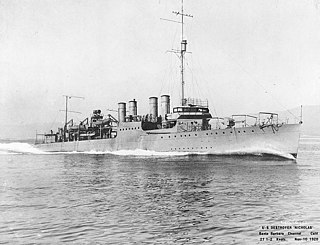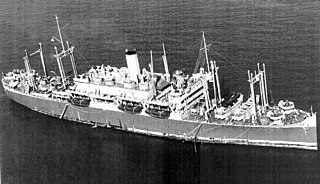The list of ship commissionings in 1923 includes a chronological list of all ships commissioned in 1923.
The list of ship commissionings in 1923 includes a chronological list of all ships commissioned in 1923.
| Ship events in 1923 | |||||||||||
| Ship launches: | 1918 | 1919 | 1920 | 1921 | 1922 | 1923 | 1924 | 1925 | 1926 | 1927 | 1928 |
| Ship commissionings: | 1918 | 1919 | 1920 | 1921 | 1922 | 1923 | 1924 | 1925 | 1926 | 1927 | 1928 |
| Ship decommissionings: | 1918 | 1919 | 1920 | 1921 | 1922 | 1923 | 1924 | 1925 | 1926 | 1927 | 1928 |
| Shipwrecks: | 1918 | 1919 | 1920 | 1921 | 1922 | 1923 | 1924 | 1925 | 1926 | 1927 | 1928 |

An aircraft carrier is a warship that serves as a seagoing airbase, equipped with a full-length flight deck and facilities for carrying, arming, deploying, and recovering aircraft. Typically, it is the capital ship of a fleet, as it allows a naval force to project air power worldwide without depending on local bases for staging aircraft operations. Carriers have evolved since their inception in the early twentieth century from wooden vessels used to deploy balloons to nuclear-powered warships that carry numerous fighters, strike aircraft, helicopters, and other types of aircraft. While heavier aircraft such as fixed-wing gunships and bombers have been launched from aircraft carriers, one has yet to successfully land on one. By its diplomatic and tactical power, its mobility, its autonomy and the variety of its means, the aircraft carrier is often the centerpiece of modern combat fleets. Tactically or even strategically, it replaced the battleship in the role of flagship of a fleet. One of its great advantages is that, by sailing in international waters, it does not interfere with any territorial sovereignty and thus obviates the need for overflight authorizations from third-party countries, reduces the times and transit distances of aircraft and therefore significantly increase the time of availability on the combat zone.
USS Ranger may refer to:
USS New Jersey may refer to one of the following ships of the United States Navy named after the U.S. state of New Jersey:

USS McCawley (DD-276) was a Clemson-class destroyer built for the United States Navy during World War I. She was armed with 4 × 4 inch and 2 × 1 pounder guns. She was commissioned on 22 September 1919, served with the Pacific Fleet for 3 years and was laid up on 7 June 1922. McCawley was recommissioned on 27 September 1923, again serving in the Pacific, and decommissioned in 1930 before being sold for scrap.

USS Toucey (DD-282) was a Clemson-class destroyer in the United States Navy following World War I. She was named for Secretary of the Navy Isaac Toucey.

USS Nicholas (DD-311) was a Clemson-class destroyer in the United States Navy following World War I. She was the first Navy ship named for Samuel Nicholas (1744–1790), the first Commandant of the United States Marine Corps.

The K-class submarines were a class of eight submarines of the United States Navy, serving between 1914 and 1923, including World War I. They were designed by Electric Boat and were built by other yards under subcontracts. K-1, K-2, K-5, and K-6 were built by Fore River Shipyard in Quincy, Massachusetts, K-3, K-7, and K-8 by Union Iron Works in San Francisco, and K-4 by Seattle Construction and Drydock Company in Seattle, Washington. All were decommissioned in 1923 and scrapped in 1931 to comply with the limits of the London Naval Treaty.

SS President Cleveland was originally built as Golden State for the United States Shipping Board (USSB), one of the planned World War I troop transports converted before construction into passenger and cargo vessels launched as Emergency Fleet Corporation Design 1029 ships first known, along with the smaller Design 1095 versions, in the trade as "State" ships due to names assigned for the nicknames of states and later as "535s" for their length overall. Almost all ships of both designs were renamed for United States presidents by May 1921, with Golden State being renamed President Cleveland. As one of the USSB-owned ships operated by agents of the board, President Cleveland was allocated to and operated by the Pacific Mail Steamship Company until sold by the USSB to the Dollar Steamship Line in 1925. After the demise of that line and creation of a new, replacement line, American President Lines, the ship remained with that line until government acquisition for the Second World War.
Two ships and a training establishment of the Royal Navy have borne the name HMS Vernon, possibly after Admiral Edward Vernon:
USS Majaba (AG-43/IX-102) was the Design 1049 cargo ship Meriden built in 1919 by the Albina Engine & Machine Works, Portland, Oregon. All the ships were requisitioned by the United States Shipping Board (USSB) for World War I service. The ship was bought by the E. K. Wood Lumber Co., of San Francisco, California in 1923 and renamed El Capitan. The ship was chartered by the U.S. Navy through the War Shipping Administration (WSA) in April 1942 and commissioned as Majaba.

SS Black Osprey was a cargo ship for the American Diamond Lines and the British Cairn Line. She was formerly known as SS West Arrow when she was launched for the United States Shipping Board (USSB) during World War I. The ship was inspected by the United States Navy for possible use as USS West Arrow (ID-2585) but was neither taken into the Navy nor ever commissioned under that name.
Five ships, one submarine and six shore establishments of the Royal Navy have borne the name HMS Vivid:

The Palestro-class torpedo boats were destroyers of the Italian Regia Marina that saw service from the mid-1920s to World War II.
Irish Pine was a 5,621 GRT cargo ship which was built in 1919 for the United States Maritime Commission (USMC) and named West Hematite. She was chartered in 1941 by Irish Shipping Ltd and renamed Irish Pine. On 16 November 1942, Irish Pine was torpedoed and sunk by U-608.

K VII was a K V-class patrol submarine of the Royal Netherlands Navy. The ship was built by Fijenoord shipyard in Rotterdam.